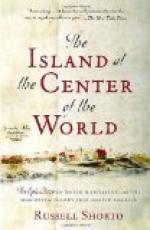There lived in New York at this time a man whose name was Samuel F.B. Morse. He was an artist and was interested in many branches of science. He had founded the National Academy of Design and was Professor of the Literature of the Arts of Design at the University of the City of New York. This man believed that an electric current could be transmitted through a wire and so make it possible to convey a message from one point to another. One night, after having worked on his idea for years, he invited a few friends to the University building, which overlooked Washington Square, and showed them the result of his labors. It was the first telegraph in the world. This was a crude affair, but Professor Morse proved that he could send a message over a wire. In the year 1845 he had advanced so far that a telegraph line was built between New York City and Philadelphia. Then all the world recognized the genius of Morse. The people of New York especially honored him, and even in his lifetime they erected a statue of him which you can see to-day in Central Park.
By this time the city had crept up to both Greenwich Village and Bowery Village, and had engulfed them. On every side were houses, some of them five and six stories high, where before they had been but two stories.
An open space nearby Bowery Village was called Astor Place. This was the scene in 1849 of a famous riot, which came about in this wise: Edwin Forrest, an American actor, and William Charles Macready, an English actor, had quarrelled about some fancied slight. So when Macready came to the city to play at the Astor Place Opera House, some friends of Forrest’s gathered and sought to prevent his acting by shouting their disapproval. This was the excuse for an unruly mob to gather outside the theatre and storm the house with stones. Macready escaped by leaving the theatre by a rear door. Then a regiment of soldiers came and after using all peaceful measures to quell the disturbance, fired upon the mob and killed many of them before the space was cleared and quiet restored.
[Illustration: Crystal Palace.]
Castle Garden, which had once been Fort Clinton, had become a place of amusement. Here Jenny Lind, “the Swedish Nightingale,” sang, and many another artist of rare ability was seen and heard.
Now, too, a World’s Fair was opened on Murray Hill. Held in a fairy-like building of glass, made in the form of a Greek cross, with graceful dome and arches, it was a Crystal Palace in fact as in name, where all the products of the world were shown. But, unfortunately, a few years later it was burned to the ground.
There are always some wise and thoughtful people who think of the comfort of others, and some of these realized that it would not be long before the Island of Manhattan would be so covered with houses that there would be no open places where one might enjoy fresh air and recreation. They said it would be well to have a garden laid out for this purpose, with walks and drives as needed. This was done and an immense tract of woodland and forest, almost as large as the city itself at the time, was set apart. As this was in the centre of the island it was called the Central Park. Millions of people have been thankful for it, although they have not put their gratitude into words.




